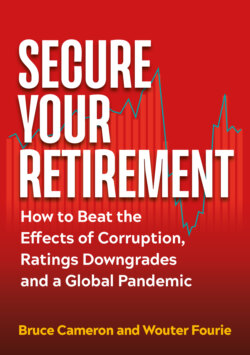Читать книгу Secure Your Retirement - Брюс Кэмерон - Страница 9
На сайте Литреса книга снята с продажи.
Solutions
ОглавлениеAgainst this background, take a look at the drawdown rates for pensioners using a living annuity as a pension proposed by the industry body, the Association for Savings and Investment South Africa (ASISA), and the draft proposals by the regulator, the Financial Sector Conduct Authority (FSCA), for a Standard on Living Annuities relating to default annuities offered by retirement funds.
ASISA details how long your income is likely to last before you hit the point of ruin:
Table 1.5: Years before your income in rands will start to reduce
| Drawdown rate | Annual investment return before inflation but after costs | ||||
| 2.5% | 5% | 7.5% | 10% | 12% | |
| 2.5% | 21 | 30 | 50+ | 50+ | 50+ |
| 5% | 11 | 14 | 19 | 33 | 50+ |
| 7.5% | 6 | 8 | 10 | 13 | 22 |
| 10% | 4 | 5 | 6 | 7 | 9 |
| 12.5% | 2 | 3 | 3 | 4 | 5 |
| 15% | 1 | 1 | 2 | 2 | 2 |
| 17.5% | 1 | 1 | 1 | 1 | 1 |
Source: ASISA Standard on Living Annuities
The FSCA states in a second draft of a Standard on Default Annuities that the recommended drawdown rates for default funds by age should be as follows:
Table 1.6: Proposed default annuity drawdown rates by age
| Age | Drawdown |
| 55 | 4% |
| 60 | 4.5% |
| 65 | 5% |
| 70 | 5% |
| 75 | 5.5% |
| 80 | 6% |
| 85 | 7% |
Table 1.7: Proposed maximum default annuity drawdown rates by age
| Age | Drawdown |
| 55 | 6.5% |
| 60 | 7% |
| 65 | 8% |
| 70 | 8% |
| 75 | 8.5% |
| 80 | 9.5% |
| 85 | 11.5% |
These FSCA lists make a lot of sense and should be followed by all annuity holders!
Now look at your expected average age of death. According to figures from the Actuarial Society of South Africa (ASSA), any female who reaches age 60 can be expected to live until 84, and any male at age 60 can be expected to live until 78 (these estimates apply to people who earn more R30 000 a year). For a couple aged 60, there is a 50 percent chance that at least one of them will still be alive at age 90. But these are averages – a lot of pensioners will live beyond these estimates.
If you want to live free of the point of ruin, you need to reduce your odds of running out of money. Your target should be to hit the 10 percent chance of living to 90 rather than assuming you will be part of the 50 percent average. This means that males must look ahead to reaching age 90 and females to 100, resulting in a planning horizon of 35 to 40 years.
Assuming an initial investment return on the average of 50 percent, only females with a drawdown rate of 3.44 percent (at most) can expect to be virtually free of their point of ruin; and only males with a drawdown rate of 4.22 percent (at most) can be more or less sure of their income until death. Any higher initial drawdown will lead to ruin.
But these tables are likely to be on the optimistic side. There is a lot of research both here and overseas that indicates that at age 60, you should not have a drawdown rate above 4 percent.
The problem is that many South African living-annuity pensioners are currently in serious trouble. With an average drawdown of about 7 percent, they are already beyond their limit.
Another problem is the structure of averages. Living-annuity pensioners are affected by the amount of capital they have, thereby generally understating the average drawdown rate if one were to determine it by the number of pensioners. In addition, the average figures don’t show which pensioner groups are most vulnerable.
The richer people, of which there are few, make up the money weight on the upside of the averages because they have lower drawdowns, often as low as 2.5 percent, and many will also reinvest their pensions in new investments. Meanwhile, people with a medium to low income, who make up the numbers, are typically on the lower side, drawing far more than the 7 percent average. So, while you have one pensioner below the 7 percent drawdown, you will also have 10 others drawing down far more than 7 percent.
Recent research by Alexander Forbes, based on the retirement funds it administers, shows that many pensioners were already in serious trouble before COVID-19. The lockdowns to combat the virus and the resulting investment market downturns have just made the situation a lot worse.
John Anderson, an actuary and a leader in retirement research, says that from Alexander Forbes’s research, it is clear that many South African pensioners are already in a bad way because of decisions they made as far back as 20 years ago when they retired – and this is apart from most pensioners saving too little while they were still employed.
COVID-19 is going to see many more pensioners hit their point of ruin far more quickly than they would have anticipated. They need to act now to try to rectify their financial positions.
